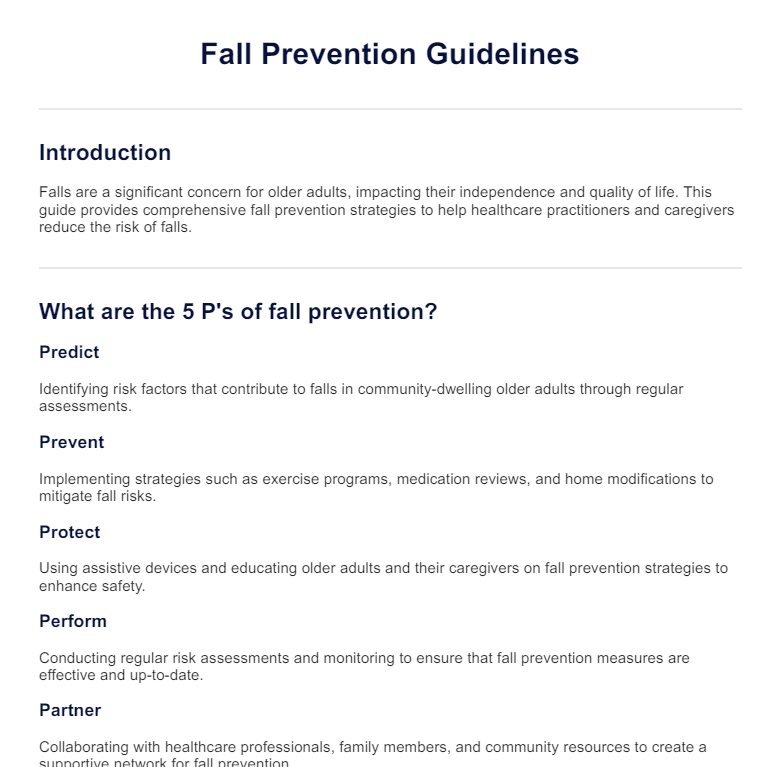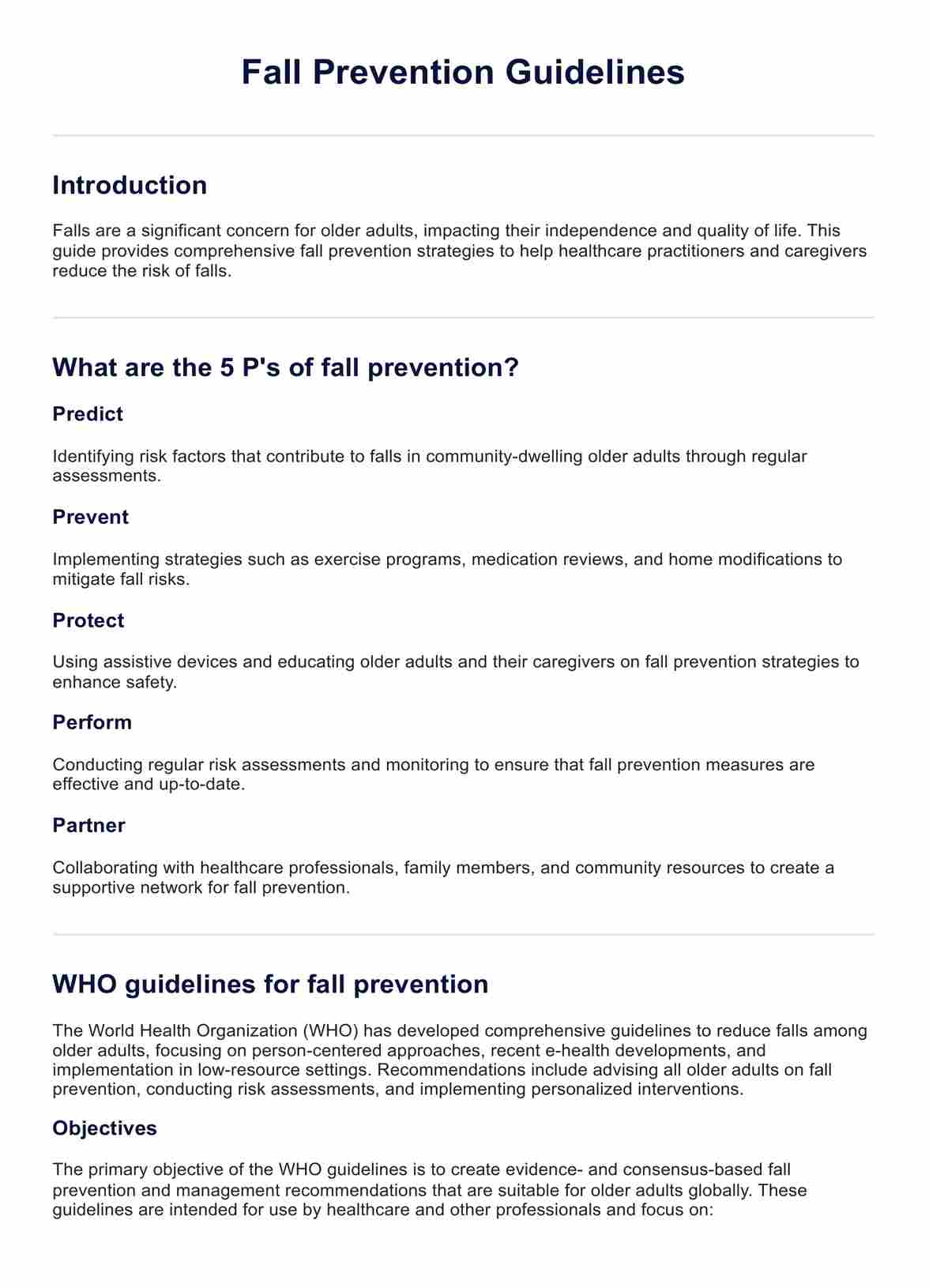Fall Prevention Guidelines PDF
Download Carepatron's free Fall Prevention Guidelines PDF, with examples and tips to help prevent falls. Stay informed and protect yourself and your loved ones.


What are the 5 P's of fall prevention?
Fall prevention is crucial, especially for community-dwelling older adults, who are at a higher risk of falls due to various risk factors. Understanding the 5 P's of fall prevention can help healthcare practitioners and individuals implement effective strategies to reduce the risk of falls. The 5 P's are:
Predict
Predicting falls involves identifying the risk factors contributing to falls. According to the Lawson Health Research Institute, risk assessment is a critical component of fall prevention. Factors such as muscle weakness, balance issues, medication side effects, and environmental hazards should be assessed regularly.
Prevent
Preventing falls involves implementing strategies to mitigate identified risk factors. Harvard Medical School emphasizes the importance of exercise programs that improve strength and balance, such as Tai Chi. Additionally, reviewing and adjusting medications that may cause dizziness or sedation is essential.
Protect
Protecting individuals at high risk of falls includes ensuring they have the necessary support and resources. The field of geriatrics and palliative medicine advocates for the use of assistive devices such as canes or walkers to aid in mobility. Protective measures also involve educating older adults and their caregivers about fall risks and prevention strategies.
Perform
Performing regular risk assessments and monitoring is crucial for ongoing fall prevention, as recommended by the World Falls Guidelines. The World Falls Guidelines recommend routine check-ups and assessments to track changes in an individual’s health.
Partner
Collaboration across various fields, such as medicine and health sciences, including experts from geriatrics, health and life sciences, and public health, can enhance the overall approach to fall prevention.
Fall Prevention Guidelines PDF Template
Fall Prevention Guidelines PDF Example
WHO guidelines for fall prevention
According to the World Health Organization (Montero-Odasso et,al. 2022) and the World Falls Guidelines, falls and fall-related injuries are prevalent among older adults, significantly impacting their functional independence and quality of life and leading to increased morbidity, mortality, and healthcare costs. Despite the severity of these issues, existing guidelines for fall prevention are inconsistent and lack a globally applicable framework. To address this gap, the World Health Organization (WHO) has developed comprehensive Fall Prevention Guidelines tailored for older adults.
Objectives
The primary objective of the WHO guidelines is to create evidence-based and consensus-based fall prevention and management recommendations suitable for older adults globally. These guidelines are intended for use by healthcare and other professionals and focus on:
- Adopting a person-centered approach that incorporates the perspectives of older adults with lived experience, caregivers, and other stakeholders.
- Addressing gaps in previous guidelines.
- Integrating recent advancements in e-health.
- Ensuring implementation is feasible in areas with limited resources, including low- and middle-income countries.
Recommendations
The WHO guidelines include several key recommendations:
- General advice and physical activity: All older adults should receive guidance on fall prevention and the importance of physical activity.
- Opportunistic case finding: For community-dwelling older adults, opportunistic case finding for fall risk is recommended.
- Comprehensive risk assessment: Older adults identified as high-risk should be offered a comprehensive, multifactorial falls risk assessment. This should aim to co-design and implement personalized multidomain interventions.
- Detailed assessment and intervention components: Specific guidelines on the components and combinations of assessments and interventions are provided, tailored to various settings and populations.
Risk factors for falls
Understanding fall risk factors is essential for developing effective fall prevention programs, especially for older adults.
Community-dwelling older adults
Due to physical, environmental, and lifestyle factors, community-dwelling older adults are particularly susceptible to falls. Studies conducted by various academic and research collaboratives have identified contributors to fall risk in this population, including age-related declines in balance and strength, chronic health conditions, and unsafe living environments.
Medication use
The use of certain medications can increase fall risk among older adults. Medications that affect the central nervous system, such as sedatives, antidepressants, and antipsychotics, can impair balance and coordination.
Environmental hazards
Environmental hazards within the home or community settings pose significant risks for falls in older adults. Common hazards are cluttered walkways, poor lighting, loose rugs, and lack of handrails.
Physical and cognitive impairments
Physical and cognitive impairments are major contributors to fall risk. Conditions such as arthritis, vision loss, and cognitive decline can severely impact an individual's ability to navigate their environment safely.
Lack of physical activity
A sedentary lifestyle can lead to muscle weakness and poor balance, increasing the likelihood of falls. Encouraging regular physical activity is a cornerstone of fall prevention.
How to prevent risk of falls in older adults
Preventing falls in older adults is crucial for maintaining their independence and quality of life. Here are five effective ways to reduce the risk of falls:
Regular exercise
Regular exercise is one of the most effective ways to prevent falls. Programs focusing on strength, balance, and flexibility, such as Tai Chi and yoga, can significantly improve stability and coordination.
Home safety modifications
Making simple modifications to the home environment can greatly reduce fall risks. Ensure walkways are clear of clutter, install grab bars in bathrooms, improve lighting in all areas, and use non-slip mats in showers and tubs.
Medication management
Reviewing and managing medications is essential in fall prevention. Certain medications, especially those affecting the central nervous system, can increase the risk of falls. Regular consultations with healthcare providers to adjust dosages or switch medications can help minimize side effects such as dizziness or drowsiness.
Vision and hearing checks
Regular vision and hearing checks are crucial for older adults. Poor vision or hearing can contribute to falls by making it difficult to detect hazards or maintain balance.
Reference
Montero-Odasso, M., van der Velde, N., Martin, F. C., Petrovic, M., Tan, M. P., Ryg, J., Aguilar-Navarro, S., Alexander, N. B., Becker, C., Blain, H., Bourke, R., Cameron, I. D., Camicioli, R., Clemson, L., Close, J., Delbaere, K., Duan, L., Duque, G., Dyer, S. M., & Freiberger, E. (2022). World guidelines for falls prevention and management for older adults: A global initiative. Age and Ageing, 51(9). https://doi.org/10.1093/ageing/afac205
Commonly asked questions
The 5 P's of fall prevention are Predict, Prevent, Protect, Perform, and Partner. These strategies focus on identifying risk factors, implementing preventive measures, ensuring safety, conducting regular assessments, and collaborating with healthcare professionals and caregivers.
National guidance for falls prevention typically includes conducting regular risk assessments, implementing multifactorial interventions, and promoting strength and balance exercises. It also emphasizes the importance of medication reviews and home safety modifications.
Common ways to prevent falls include regular exercise to improve strength and balance, home safety modifications like installing grab bars and improving lighting, and managing medications that may cause dizziness or balance issues.







































































































